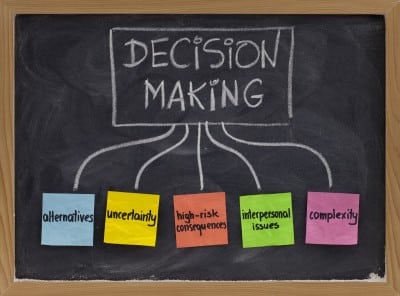2 Secrets To Being A Wiser Decision Maker

 How do you make decisions?
How do you make decisions?
Do you journal? List the pros and cons? Play devil’s advocate with yourself (or a loved one)?
Recently I was talking to a prospective client who was having trouble making a big decision in her business. I could see her beginning to slip into
analysis paralysis. You know what I’m talking about right? It’s when your mind starts circling around the possibilities like a cat chasing his tail, and it becomes hard to just step away and decide.
Although there’s a whole science of how to become a wiser decision maker (many detailed in the new book “Decisive: How to Make Better Choices in Life and Work” by Chip and Dan Heath) there are two well-researched strategies that I find particularly helpful.
1) Be A Satisficer (Not a Maximizer)
Happiness Researcher Barry Schwartz has found that there are two types of decision makers.
Maximizers: Those that must investigate all the options before making a decision.
Satisficers: Those that set their criteria for necessary success first, and then pick the first option that meets all those criteria.
I’ll be honest, I have a tendency to fall into the first camp. Even once I’ve found a good option, I’m often still searching “just a little bit further” to make sure I can’t find an even better option before I ultimately decide.
Let me tell you that in the home renovation process, as in business, there are big rewards to the thoughtful yet quick decision makers. For renovating, it’s easy to see that a quick turnaround on decisions, while choosing a great first option, keeps your project on schedule (and hopefully on budget).
Similarly in work, if you keep perseverating on and “perfecting” a project before releasing it to your boss, a client or the public, the end result is you’ll put a lot less of your “great-enough” work out there.
Keep in mind that Satisficers don’t necessarily settle for “less.” You can have very high criteria that must be met before choosing an option. It’s just that Satisficers are willing to end the search as soon as they find the first excellent choice – they don’t need to keep searching to choose between 3 fabulous ones.
So let me know in the comments which are you? Maximizer or Satisficer?
2) Never Choose “Should I Stay Or Should I Go?” – Broaden
 Now that I’ve given you an explanation for why simplifying your decision can make you a lot happier – here’s the corollary.
Now that I’ve given you an explanation for why simplifying your decision can make you a lot happier – here’s the corollary.
You never want to make a choice between “Should I do this one thing or not?” People think this is a choice between two options, but it’s really just deciding yes/no on one option.
Instead, authors Chip and Dan Health point out, you want to just add one other option to your list of possibilities to broaden your thinking. (Note to self: not 4 other options – just one!)
Having one other option changes the question from “whether or not?” which can keep people circling around in their head for years, to making a decision between two very different choices.
For instance, let’s suppose you were trying to decide whether or not to leave your job. People have debated this question for themselves for years! However, if you start asking, “Do I want to stay at Company A or leave for Company B?” all of a sudden your decision becomes much less theoretical and much more actionable to choose between the two options. You might even find, as researchers suggest, that broadening your scope by one option, leads you to ultimately create and choose option 3 – something you could’ve never conceived of when just ping-ponging “yes/no” around in your head.
 Start using these two ninja decision-making tricks and I guarantee you’ll find that you can make better, faster decisions – and stay happier in the process.
Start using these two ninja decision-making tricks and I guarantee you’ll find that you can make better, faster decisions – and stay happier in the process.
So whether you’re facing a home remodel, a business quandary or even a problematic relationship – pick your criteria for success, make sure you have at least two real options – then go for it! And come back and comments below to let me know what you find!